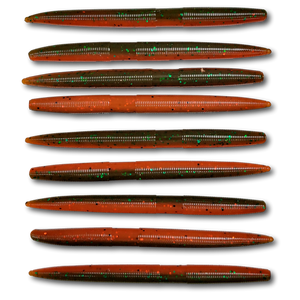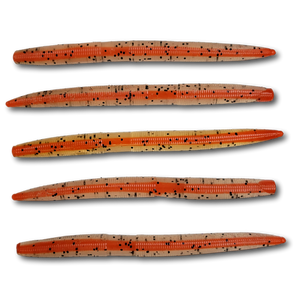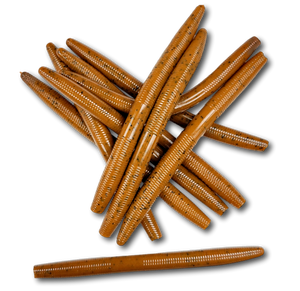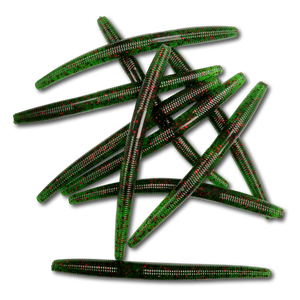Stick Baits
What is a Stick Bait?
Stick baits (stick worms) are soft-plastic cylinders—typically 3"–10"—that catch fish with a natural shimmy on the fall and a subtle quiver on slack-line twitches. They “match nothing” yet suggest fry, worms, leeches, and minnows. Performance hinges on fall rate, salt/density, diameter, and buoyancy.
- Length & diameter: 5" is the all-arounder; 3–4" for cold fronts/ultra-clear; 6–7" when you want presence; 8–10" for power-finesse, night fishing, or big-fish culling.
- Salt & density: heavy-salt PVC sinks fast with pronounced side-to-side shimmy; buoyant/elastomer sticks excel when you want slow fall or upright “stand-up” posture on Ned/shaky heads.
- Shape/texture: smooth = faster fall; flats/ribs = more drag/micro-vibration; tapered tips improve wacky/Neko hookup.
Order of operations: tune fall rate first (salt/weight/diameter), then size, then color.
Where Stick Baits Shine (Rigs & Situations)
- Wacky / Weightless: targets, docks, shade lines, brim beds—dead-fall + two twitches → pause. Post-spawn killers.
- Texas (light): grass edges and wood. Add 1/32–1/8 oz for distance/current; skip under cover with 5–7" or even 8–10" when seeking a bigger bite.
- Neko: nail weight in the head for bottom “pecking” feedback—reads rock/sand transitions on points and breaks.
- Ned: 3–4" buoyant sticks; cut-down 5" also works. Drag, shake, soak in clear/pressured water.
- Dropshot / Hover: nose-hooked small sticks for smallmouth/suspended fish. Keep horizontal with light-wire hooks.
- Carolina / Split-shot: mid-depth roaming fish; sticks track straight without spinning leaders.
Tackle: ML–M spinning (6’10–7’3) + 6–10 lb fluoro or braid-to-fluoro for wacky/Neko/dropshot. M–MH casting + 12–17 lb fluoro for Texas around cover.
Colors & Materials
- Clarity mapping: Clear → green pumpkin, watermelon, smoke, translucent laminates; Stain → black/blue, junebug, darker cores; Muddy → solid black/black-red for silhouette.
- Seasonal accents: pre-spawn reds/orange flake (craw window); fall shad tints (pearl/white backs); bluegill laminates near beds.
- Material care: store buoyant TPE/elastomer separate from salted PVC; keep colors grouped to avoid dye bleed.
If followers won’t commit, adjust fall rate before changing color—often it’s speed, not tint.
Best Colors & Sizes for Stick Baits
- Clear water: natural tones—green pumpkin, watermelon, baby bass, smoke, translucent laminates.
- Stained/murky: high-contrast—junebug, black/blue, black with chartreuse tail accents.
- Low light / night: dark solids (black, purple) for a strong silhouette.
- Sizes: 4–5" for finesse/smaller fish; 6–10" for presence, warmer water, night, or a bigger-bite program.
Why Stick Baits Are So Effective
Balanced bodies and soft materials create a subtle side-to-side shimmy on the fall and a natural quiver on slack-line twitches—enough to trigger both feeding and reaction strikes, even on pressured or lethargic fish.
They’re also modally versatile: weightless for shallow cover, lightly weighted for wind/current, nail-weighted (Neko) for bottom feedback, or trimmed for Ned/dropshot. That adaptability makes them a reliable option virtually year-round.
When & Where to Use Stick Baits
- Spring: weightless/wacky pitched to beds, shade, and cover; Neko along first breaks.
- Summer: Texas/Carolina along ledges, grass lines, and deeper edges; upsize to 6–10" at night.
- Fall: shad-leaning colors along riprap, wind lanes, and flats where bass chase bait.
- Winter: 3–4" on Ned/dropshot with long pauses and minimal movement near deeper structure.
They shine in lakes, rivers, reservoirs, and ponds—especially in clear or heavily pressured water.
Wacky & Weightless — Skipping, Shade Lines, Post-Spawn
Center-hung hook frees both ends to quiver. Skip deep under cover; control slack on the fall.
- Hook: #1–1/0 wacky/splitshot; O-rings/shrink-tube extend bait life; weedguard models for cover.
- Line: 10–15 lb braid main → 6–10 lb fluoro leader (6–8’). Pure fluoro if ultra-finicky.
- Cadence: dead-fall → 2–3 light twitches → 5–15 s pause. Strikes often happen during the fall or right after first twitch.
- Sizes: 4–6" most days; go 3–4" in cold fronts; 7–10" to trigger bigger fish around shade/docks.
Texas Rig — Grass Lines, Wood, Skipping Cover
- Hook/weight: 2/0–3/0 EWG or straight shank. 1/32–1/8 oz bullet for wind/current; peg in grass.
- Retrieve: swim-stop, hop-pause, slow drag along edges/isolated targets. Long casts along shade lines.
- When: stain/wind increase, accuracy needed, or fish bury in cover. Upsize to 6–10" for presence/bigger bite windows.
Neko Rig — Bottom Read & Steep Breaks
- Rig: nail weight in head, O-ring slightly forward of center, hook point up—bait “pecks” bottom.
- Where: points, channel swings, gravel-to-mud transitions; quickly finds hard spots.
- Cadence: short shakes with slack control; drag 6–18" and soak. Expect pressure bites.
Ned Rig — Cold Fronts, Pressured Fish, Small Profiles
- Bait: buoyant 3–4" sticks; cut a 5" in half if needed. Flat-cut tail down on mushroom heads.
- Retrieve: drag-deadstick-drag; glide-and-shake; slow swim. Let it stand on the pause.
- Heads: 1/16–1/10–1/6 oz by depth/wind; light-wire hooks.
Dropshot / Hover-Strolling — Clear & Deep
- Hook: #2–#1 dropshot/straight shank, nose-hooked for horizontal posture.
- Leader: 6–8 lb fluoro (18–30" over grass). Subtle shakes while drifting/current-walking.
- Targets: suspended bait balls, smallmouth lakes, current seams, deep humps.
Best by Conditions (Clear • Stain • Cold Front • Spawning • Night)
- Ultra-clear: 3–5" translucent/natural on wacky, Neko, or dropshot. Long casts; longer pauses.
- Stained: 5–7" darker/contrasty on Texas or weighted wacky. Shorter pauses; tighter to cover.
- Cold front: downsize to 3–4" on Ned/dropshot or a slow-fall wacky; extend pauses to 10–15 s.
- Spawn/post-spawn: wacky skipped to shade/bed perimeters; Neko along first breaks for roamers.
- Night/dirty: 7–10" dark solids on Texas/weighted wacky for silhouette and displacement.
Water clarity rule: Clear = natural/translucent; Stain = contrast (black/blue, junebug); Muddy = silhouette.
Carolina Rig — Cover Water & Structure
- Where: long points, humps, ledges, and transition zones where fish roam or wind stacks bait.
- Setup: 1/4–3/4 oz egg sinker, 18–36" leader, 2/0–3/0 hook. The stick bait tracks straight behind the weight and stays near bottom.
- Retrieve: slow drag with brief pauses; let the bait glide and settle naturally between pulls.
How to Rig a Stick Bait (Step-by-step)
- Select size/plastic: start 5" salted for all-around; 3–4" buoyant for finesse; 6–10" for presence/cover or night.
- Wacky setup: slide an O-ring slightly forward of center; hook perpendicular through ring; weedguard hook in cover.
- Texas setup: 2/0–3/0; texpose point; add 1/32–1/8 oz bullet for wind/distance; peg in grass.
- Line control: keep semi-slack on the fall to preserve shimmy; watch for “tick/side-swim” bites.
- Tune: too fast? remove weight or pick lower-salt plastic / larger diameter. Too slow? add nail/bullet weight or downsize diameter.
Missed bites often mean moving it too soon, hook too large, or a fall rate that’s off for the mood.
Seasonal & Weather-Based Selection
- Spring (pre-spawn 48–58°F): 4–6" wacky in natural/reds around rock/wood; Neko on points.
- Spawn/guarding: 4–5" wacky skipped to shade/bed edges; short hops with long pauses.
- Summer: Texas/weighted wacky for edges/cover; upsize 6–10" at night or in stain.
- Fall: shad tints on weightless wacky/Texas to chase wind lanes; speed up with short pauses.
- Winter: 3–4" Ned/dropshot; minimal movement; deadstick more.
Wind adds life; sun angle pins fish to shade. Adjust fall rate first, then color, then size.
Tips for Fishing Stick Baits
- Match cadence to mood: cold/tough = dead-fall and long pauses; warm/active = sharper twitches or hop-pause.
- Line choices: 6–12 lb fluoro for most finesse presentations; braid-to-fluoro on spinning for casting distance and sensitivity; step up line and hooks around heavy cover.
- Control fall rate: add/remove weight, change salt/density, or adjust diameter. This often matters more than color.
- Salvage trims: recycle torn or cut baits into Ned/dropshot pieces to extend value.
Common Mistakes & Quick Fixes
- Line twist: if baits spin, add a small barrel swivel or switch to Neko/Texas.
- Tearing through baits: O-rings/shrink tube + light-wire hooks; sweep set, don’t snap.
- No commitments: adjust fall rate before color; lengthen pauses; downsize to 3–4".
- Too-fast fall: remove weight, use lower-salt plastic, or upsize diameter.
Maintenance & Storage
- Separate materials: buoyant TPE/elastomer vs salted PVC—store apart. Group by color family to avoid bleed.
- Keep straight: long sticks kink in heat—use original clamshells or straight trays.
- Kit: O-rings, nail weights, shrink tube, small swivels, wacky tool in one box.
- On-water triage: salvage torn halves for Ned/dropshot; re-ring baits that are still straight.
FAQs
What size should I start with? 5" covers ~80% of scenarios. Downsize to 3–4" in clear/cold fronts; upsize 6–10" for presence, night, or bigger bites.
Which colors where? Clear = green pumpkin/watermelon/smoke; Stain = black/blue, junebug; Muddy = solid black/black-red.
Wacky or Texas? Wacky for open/targets/pressure; Texas for grass/wood/accuracy. Neko when you need bottom read and speed.
Do scents help? Yes—boost hold time and confidence, especially under pressure or cold fronts.
Cut-downs? Absolutely—trim to 3–4" for Ned/dropshot; recycle torn ends.













